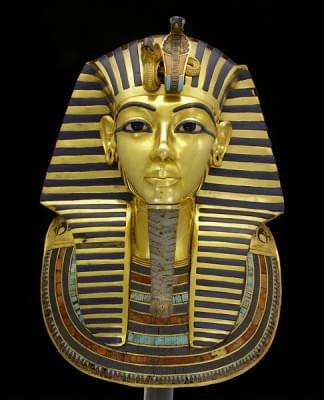Henkel glues Tut Ankh Amun’s beard
This news went around the world: The beard of the world-famous, more than 3,000-year-old golden mask of Tut Ankh Amun fell off during a cleaning procedure and was hastily glued back on improperly. Yesterday the restored golden mask of the young pharaoh was presented to the world public during a ceremony at the Egyptian museum in Cairo. To make sure that the beard now sticks to the mask a customized adhesives solution from Henkel is used.
Christian Eckmann of the Römisch-Germanisches Zentralmuseum in Mainz, who is responsible for the restoration project, explicitly highlighted the contribution of Henkel at yesterday’s press conference: “The competent advice and support from the experts from the Henkel Adhesives research department significantly contributed. We were able to remove the improperly glued beard from the mask and fix it with a customized solution provided by Henkel.” Eckmann also thanked the Gerda Henkel Stiftung which supported the restoration works with a funding.
“We are happy to be part of this amazing project”, said Ahmed Fahmy, Vice President North Africa & President Henkel Egypt. “Egypt is an important market for Henkel with a long tradition. We are proud that we were able to contribute with our expertise to restoring such an outstanding piece of history!”
Support from adhesives experts
The story began when Dr. Dirk Kasper, a specialist in hotmelt adhesives, read a newspaper article about how the incorrect use of adhesives had damaged the more than 3,000-year-old mask of Tut Ankh Amun. He called the restoration team straight away to offer support. “We are the experts in adhesives,” said Kasper. And the support was greatly appreciated.
His colleague Dr. Rainer Schönfeld was then invited to examine the mask with his team: “The beard had been incorrectly glued to the mask using an epoxy. We have a great deal of expertise about epoxy technologies – and we also know how to remove this kind of adhesive.”
His team conducted detailed analysis and developed a method to remove the epoxy glue from the mask without leaving any residue. “At the same time, we checked Henkel’s comprehensive technology portfolio to see what kind of glue would be best suited for the restoration,” explained Dirk Kasper. The requirements were high: The adhesive has to be removable without leaving any residue, and had to be able to withstand the high temperatures in Egypt as well as vibration during the transport.
In numerous physical measures, 3D-models and application tests the experts were able to develop the ideal adhesive. “It is our daily business to design high-tech glue – but this project was extremely exciting for the whole team! We are all extremely proud that a high-tech hotmelt adhesive from Henkel is now holding together the world-famous mask of Tut Ankh Amun!”
Related news
Henkel: 3,000 accident-free days
🎧 Hallgasd a cikket: Lejátszás Szünet Folytatás Leállítás Nyelv: Auto…
Read more >We took you on a flight! (Part 2)
🎧 Hallgasd a cikket: Lejátszás Szünet Folytatás Leállítás Nyelv: Auto…
Read more >Henkel won the top prize in the BeneFit PRIZE large company category again this year
🎧 Hallgasd a cikket: Lejátszás Szünet Folytatás Leállítás Nyelv: Auto…
Read more >Related news
Christmas shock in commerce: for the first time, we can pay with bank cards in fewer places
🎧 Hallgasd a cikket: Lejátszás Szünet Folytatás Leállítás Nyelv: Auto…
Read more >Most grocery chains will be open until noon on December 24th
🎧 Hallgasd a cikket: Lejátszás Szünet Folytatás Leállítás Nyelv: Auto…
Read more >ORLEN DESPAR stores are open even at Christmas
🎧 Hallgasd a cikket: Lejátszás Szünet Folytatás Leállítás Nyelv: Auto…
Read more >







